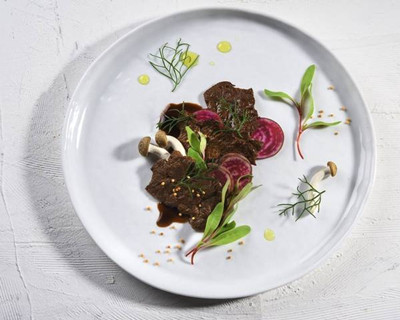(单词翻译:单击)
听力文本
Israeli Company Claims Invention of First 'Lab Grown' Steak
An Israeli company says it has produced the world's first steak "grown" in a laboratory.
Researchers from Tel Aviv-based Aleph Farms say they successfully created the meat using methods that do not harm animals. The company claims its scientific invention has the "true texture and structure of beef muscle tissue steak."
Shulamit Levenberg is the co-founder and chief scientific officer of Aleph Farms. She considers the company's product "clean meat." She says this is because it is grown in a clean, controlled setting and does not require the killing of an animal.
Some opponents of lab meat production have rejected the term "clean meat" and suggested that "synthetic meat" would be more exact. Many companies have attempted to create realistic meat replacements with mostly vegetable-based products. Others, like U.S.-based company Just, also have plans to produce beef grown inside a lab.
The process begins when scientists collect live cell tissue from real cows. Aleph Farms says this is easily completed without harming the animals. The cells are then fed nutrients to make them grow.
The cells are then combined through a process the company says uses three-dimensional or 3-D technology to form realistic tissue. The company says small pieces of meat can be produced in as little as three weeks, with each costing about $50 to make.
Levenberg says animal meat grown in a controlled setting has mostly been limited to simple structures of one or two kinds of cell tissue. This has meant companies have struggled to produce a lab-grown meat that enjoys the similar texture, shape and taste of real steak. So far, cell-created meat development has been limited to ground meat.

Levenberg said Aleph Farms uses four different kinds of animal cells found in traditional cuts of meat. As a result, it can produce a product containing similar properties of steak, including muscle, fat and connective tissues. The company considers this "the key to a product that will be closer to the beef that people crave."
Aleph Farms includes a video on its website that shows its steaks being cooked, prepared and eaten.
The company is still developing its technology in an effort to bring production costs down. The steak product is expected to be ready to sell within two years. Aleph Farms hopes the process can greatly reduce the amount of land, water and food resources necessary for traditional beef production methods.
The United Nations Food and Agriculture Organization has estimated that demand for meat is likely to grow by nearly 70 percent by 2050. The U.N. says such demand could create resource shortages around the world and have harmful effects on the environment.
Earlier this year, Dutch company Mosa Meat announced plans to make and sell laboratory-grown meat in restaurants by 2021. The company has been developing its methods since announcing in 2013 it had produced the world's first hamburger in a lab.
Mosa Meat uses a similar scientific process for creating beef. But instead of steak, Mosa Meat plans to begin its market launch with ground beef products, mainly for making hamburgers.
The company says its production process uses 96 percent less greenhouse gas emissions than traditional meat production. In addition, it says it requires 99 percent less land and 96 percent less water.
I'm Bryan Lynn.
重点解析
重点讲解:
1. so far 迄今为止;到目前为止;
So far they have not found a way to fight the virus.
迄今为止,他们还没有找到一种对抗该病毒的方法。
2. bring down 降(价);
The company is trying every means to bring down the wholesale price of its products.
公司使用了各种方法降低产品批发价格。
3. be ready to do sth. 准备好的;胜任的;
The picture is now ready to be mounted and framed.
这幅画现在可以装裱加框了。
4. instead of 代替…;而不是…;
Instead of staying in the here and now, you bring up similar instances from the past.
你没有紧扣眼前所发生的事,而是只提出了一些过去的类似事例。
参考译文
以色列公司发明出首款人造牛排
一家以色列公司表示,他们生产出了世界上首款在实验室培育的牛排。
阿勒夫农场是一家总部位于特拉维夫的公司,该公司的研究人员表示,他们用不伤害动物的方法成功生产出了人造牛排。该公司称,其科学发明拥有“真正的牛排肌肉组织的纹理和结构”。
舒拉米特·利文伯格是阿勒夫农场的联合创始人兼首席科技官。她认为公司的产品是“净肉”。她说,因为这种肉是在清洁且可控的环境中培育的,而且不需要杀害动物。
一些反对实验室肉类生产的人拒绝“净肉”这种说法,他们认为“人造肉”是更为准确的说法。许多公司尝试用主要以蔬菜为基础的产品来制造逼真的肉类替代品。另外,美国公司Just也计划在实验室培育牛肉。
生产过程由科学家从真牛身上收集活细胞组织开始。阿勒夫农场表示,这一采集步骤可以在不伤害动物的情况下轻松完成。随后,科学家给细胞注入营养物质,让细胞生长。
之后让细胞结合,该公司表示,这一过程利用3D技术制造出逼真的组织。公司表示,小块肉可以在三周内生产出来,每块肉的生产成本约为50美元。
利文伯格表示,在可控环境中生长的动物肉基本上受限于一种或两种简单的细胞组织结构。这意味着各公司生产的实验室培育肉要尽量与真正牛排的纹理、形状和味道类似。截至目前,用细胞创造肉类仅限于碎肉。
利文伯格说,阿勒夫农场使用传统肉类切割中发现的四种细胞类型。因此,该公司可以生产出含有类似于牛排属性的产品,包括肌肉、脂肪和结缔组织。阿勒夫农场认为这是“生产出接近于人们渴望的牛肉产品的关键所在”。
阿勒夫农场在官网上发布了一段视频,记录了其生产的牛排被烹饪、准备和食用的过程。
该公司仍在进行技术开发,以降低生产成本。这种牛排产品将在两年内上市。阿勒夫农场希望这一过程能大幅减少传统牛排生产方法所需的土地、水和食物资源。
联合国粮食及农业组织估计,到2050年肉类需求很可能增长近70%。联合国称,如此大的需求可能导致全世界资源短缺,并对环境造成有害影响。
今年早些时候,荷兰公司Mosa Meat宣布计划在2021年向餐厅生产并销售实验室培育的肉类。该公司在2013年宣布生产出了世界上首个实验室培育的汉堡,自那之后一直在开发生产方法。
Mosa Meat公司用一种类似的科学过程生产牛肉。不过Mosa Meat公司没有生产牛排,而是计划上市碎牛肉产品,主要用来生产汉堡。
该公司表示,与传统肉类生产相比,其生产过程所排放的温室气体减少了96%。另外,Mosa Meat公司说其所需要的土地和水资源分别减少了99%和96%。
布莱恩·林恩报道。
译文为可可英语翻译,未经授权请勿转载!


